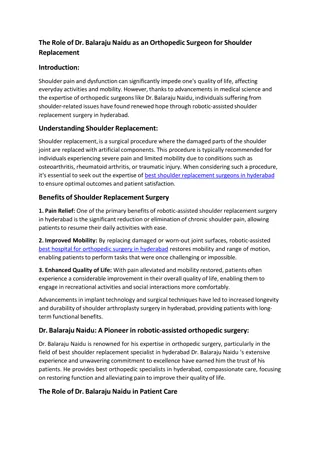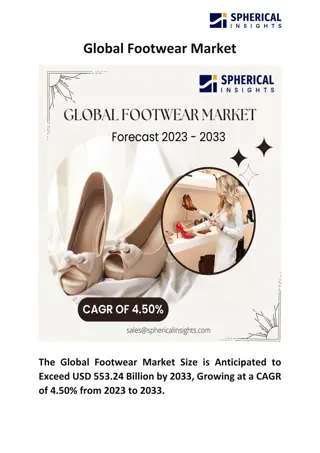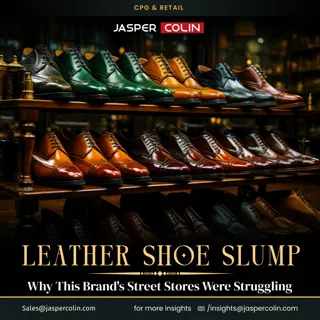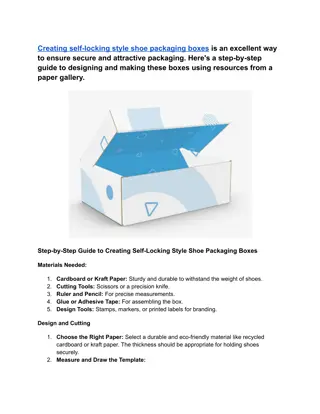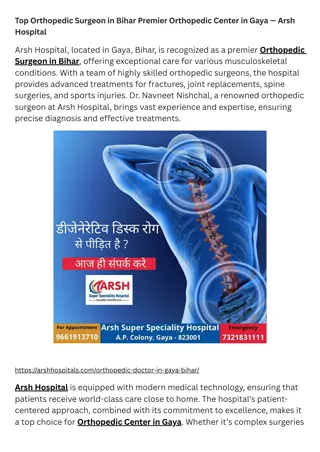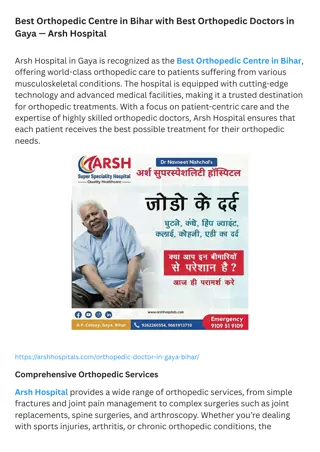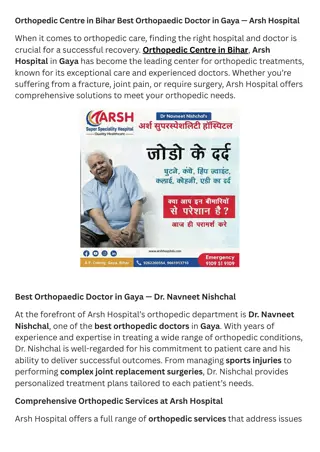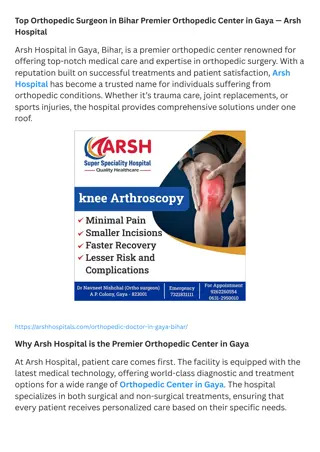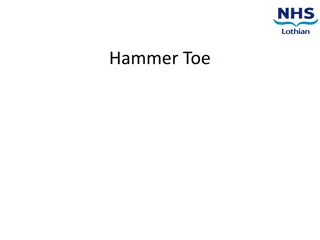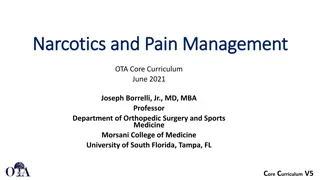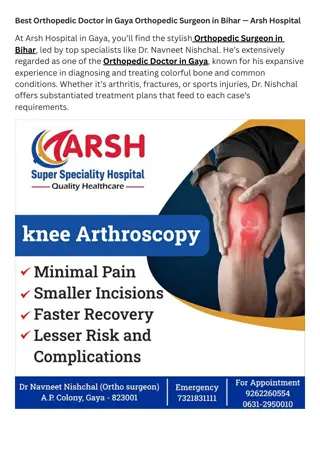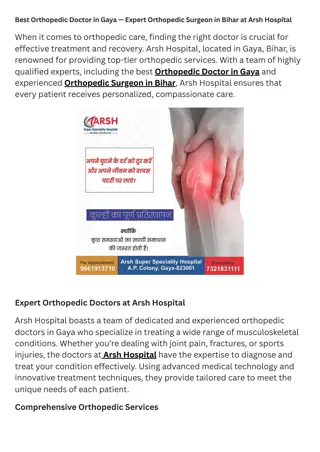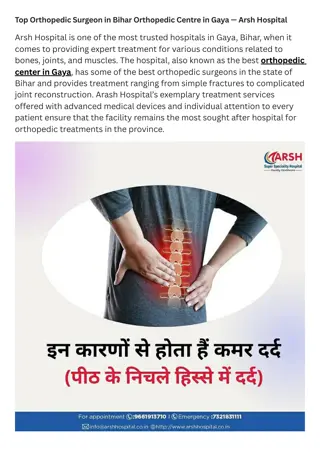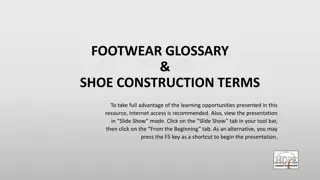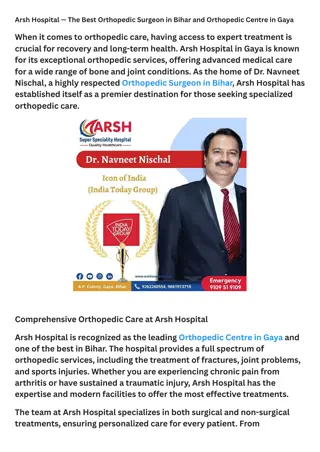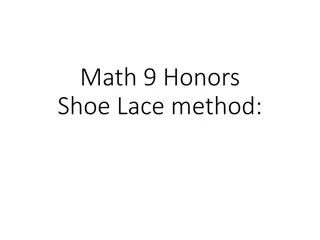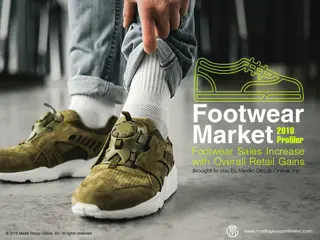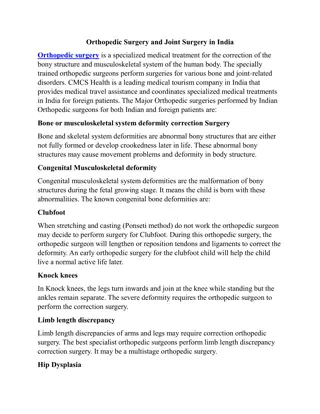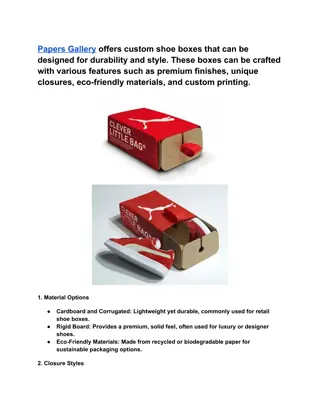Footwear Management and Orthopedic Shoe Standards
This resource provides valuable information on off-the-shelf shoes for foot pathology management, including extra-depth shoes designed to relieve excessive foot pressure and accommodate foot deformities. It also outlines the specifications for orthopedic footwear, emphasizing the importance of correct construction, material quality, and closure types. Key terms related to orthopedic footwear and shoe coding for modifications are also discussed, offering insights into the world of specialized footwear for foot health.
Download Presentation

Please find below an Image/Link to download the presentation.
The content on the website is provided AS IS for your information and personal use only. It may not be sold, licensed, or shared on other websites without obtaining consent from the author. Download presentation by click this link. If you encounter any issues during the download, it is possible that the publisher has removed the file from their server.
E N D
Presentation Transcript
Shoes and Foot Management Off-the-Shelf Shoes for Management of Foot Pathology. To take full advantage of the learning opportunities presented in this resource, view the presentation in Slide Show mode. Click on the Slide Show tab in your Microsoft PowerPoint tool bar, then click on the From the Beginning tab. As an alternative, you may press the F5 key as a shortcut to begin the presentation.
Extra Depth Shoes. Purpose: Designed to relieve excessive foot pressure Hammertoes Bunions Extreme foot shapes. Construction Features: Seamless or limited seams at forefoot and interior Deeper toe box: 3/16 inch to inch Accommodative materials
Extra Depth Shoes. Extra-depth shoe standards: Minimum of 3 widths Minimum of 3/16 inch of extra-depth Limited seams at the toe Closed toe Other factors for high quality: Genuine leather upper Foam-padded collar Long medial counter High toe box Steel shank Adaptable sole for modifications, such as lifts, rocker bottoms, etc.
Orthopedic Footwear Definition. Shoes, shoe modifications or shoe additions which are used to: Correct, accommodate or prevent a physical deformity or range of motion malfunction in a diseased or injured part of the ankle or foot Support a weak or deformed structure of the ankle or foot Form an integral part of a brace. Minimum orthopedic shoe specifications consist of: Blucher or Balmoral construction Leather construction or synthetic material of equal quality Welt construction with a cement attached outsole or sewn on outsole Upper portion properly fitted as to length and width No unit sole Bottom sized to the last Closure appropriate to foot condition (Velcro strap or lace closure preferred) Full range of widths, not just narrow, medium, wide Extended medial counter and firm heel counter. Sneakers and athletic shoes are not considered orthopedic shoes by the Medicaid Program and therefore are not Medicaid reimbursable.
Orthopedic Footwear. Key Terms Blucher Shoe Lace-up shoe One piece vamp Balmoral (Bal/Oxford) Shoe Lace-up shoe Typically with side seam Welt Construction Strip of material sewn to upper Sole is sewn or attached to welt Allows for sole repair and modification Counter Reinforcement between lining and upper Stabilizes heel in early stance May also be external to shoe (heel cap)
Shoe Coding: Modifications. Elevations L3300 Lift, elevation, heel, tapered to metatarsals, per inch L3310 Lift, elevation, heel and sole, neoprene, per inch L3332 Lift, elevation, inside shoe, tapered, up to one-half inch Heel Modifications L3350 Heel wedge L3390 Outflare wedge Other Modifications L3580 Orthopedic shoe addition, convert instep to Velcro closure L3649 Orthopedic shoe, modification, addition or transfer, not otherwise specified
Foot and Shoe Measurement. Brannock Device Available for age/gender Men s Sizes 4 to 16 Width sizes 3A to 3E Women s Sizes 3 to 13 Width sizes 4A to 2E Junior Infant 0 to child s size 5 (approximately age 10) Key Measurements Heel-to-toe length Arch length (heel to 1stmetatarsal head) Width of foot Shoe Sizing Correct size is larger of two length measurements
Using the Brannock Device. Foot Length Move all adjustments to their largest settings With the patient standing, place the foot in the correct side of the device with the heel firmly against the heel cup Press the longest toe lightly and read the foot length
Using the Brannock Device. Arch Length Slide the pointer until it is centered on the first metatarsal head and record the arch length Foot Width Slide the width bar until it firmly contacts the lateral side of the foot Locate the shoe size as determined by the larger of the two measurements (foot length versus arch length) Read the width that corresponds to the appropriate shoe size
Foot and Shoe Measurement. Shoe Sizing Schemes Shoe sizes are related to the length of the last, which is a foot- shaped template used for shoe fabrication. The American size of the shoe is three times the heel-to-toe length of the foot (in inches) minus a constant. The subtractive constant is 22 for men, 21 for women, 9.75 for children up to size 13 . Example: a man s foot that is 10.5 long requires an American shoe size 9.5. 3 x 10.5 = 31.5 22 = 9.5. Each half size increment is 1/6 of an inch (4.23 millimeters). Most countries in continental Europe and in Latin America follow some version of the French rule. Shoe size is 1.5 times the length of the last measured in centimeters, irrespective of gender or age.
U.S. Mens Shoe Sizes. Size 6 = 9.31 inches long. Widths: C Narrow: 3.3 inches; D Medium/Standard: 3.5 inches; E Wide: 3.7 inches. Size 8.5 = 10.19 inches long. Widths: C Narrow: 3.6 inches; D Medium/Standard: 3.8 inches; E Wide: 4 inches. Size 6.5 = 9.5 inches long. Widths: C Narrow: 3.3 inches; D Medium/Standard: 3.6 inches; E Wide: 3.8 inches. Size 9 = 10.31 inches long. Widths: C Narrow: 3.6 inches; D Medium/Standard: 3.9 inches; E Wide: 4.1 inches. Size 7 = 9.69 inches long. Widths: C Narrow: 3.4 inches; D Medium/Standard: 3.6 inches; E Wide: 3.8 inches. Size 9.5 = 10.5 inches long. Widths: C Narrow: 3.7 inches; D Medium/Standard: 3.9 inches; E Wide: 4.1 inches. Size 7.5 = 9.81 inches long. Widths: C Narrow: 3.4 inches; D Medium/Standard: 3.7 inches; E Wide: 3.9 inches. Size 10 = 10.69 inches long. Widths: C Narrow: 3.8 inches; D Medium/Standard: 4 inches; E Wide: 4.2 inches. Size 8 = 10 inches long. Widths: C Narrow: 3.5 inches; D Medium/Standard: 3.8 inches; E Wide: 3.9 inches. Size 10.5 = 10.81 inches long. Widths: C Narrow: 3.8 inches; D Medium/Standard: 4.1 inches; E Wide: 4.3 inches.
U.S. Mens Shoe Sizes, continued. Size 11 = 11 inches long. Widths: C Narrow: 3.9 inches; D Medium/Standard: 4.1 inches; E Wide: 4.3 inches. Size 13.5 = 11.81 inches long. Widths: C Narrow: 4.2 inches; D Medium/Standard: 4.4 inches; E Wide: 4.8 inches. Size 11.5 = 11.19 inches long. Widths: C Narrow: 3.9 inches; D Medium/Standard: 4.2 inches; E Wide: 4.4 inches. Size 14 = 12 inches long. Widths: C Narrow: 4.2 inches; D Medium/Standard: 4.5 inches; E Wide: 4.9 inches. Size 14.5 = 12.19 inches long. Widths: C Narrow: 4.3 inches; D Medium/Standard: 4.6 inches; E Wide: 4.9 inches. Size 12 = 11.31 inches long. Widths: C Narrow: 4 inches; D Medium/Standard: 4.3 inches; E Wide: 4.4 inches. Size 15 = 12.31 inches long. Widths: C Narrow: 4.3 inches; D Medium/Standard: 4.6 inches; E Wide: 5 inches. Size 12.5 = 11.5 inches long. Widths: C Narrow: 4.1 inches; D Medium/Standard: 4.3 inches; E Wide: 4.5 inches. Size 13 = 11.69 inches long. Widths: C Narrow: 4.1 inches; D Medium/Standard: 4.4 inches; E Wide: 4.6 inches.
U.S. Womens Shoe Sizes. Size 5 = 8 11/16 inches long. Widths: Narrow: 2.81 inches; Average: 3.19 inches; Wide: 3.56 inches; Extra Wide: 3.94 inches. Size 7.5 = 9 inches long. Widths: Narrow: 3.13 inches; Average: 3.5 inches; Wide: 3.88 inches; Extra Wide: 4.25 inches. Size 5.5 = 8 13/16 inches long. Widths: Narrow: 2.88 inches; Average: 3.25 inches; Wide: 3.63 inches; Extra Wide: 4 inches. Size 8 = 9 11/16 inches long. Widths: Narrow: 3.19 inches; Average: 3.56 inches; Wide: 3.94 inches; Extra Wide: 4.31 inches. Size 6 = 9 inches long. Widths: Narrow: 2.94 inches; Average: 3.31 inches; Wide: 3.69 inches; Extra Wide: 4.06 inches. Size 8.5 = 9 13/16 inches long. Widths: Narrow: 3.25 inches; Average: 3.63 inches; Wide: 4 inches; Extra Wide: 4.38 inches. Size 6.5 = 9 3/16 inches long. Widths: Narrow: 3 inches; Average: 3.38 inches; Wide: 3.75 inches; Extra Wide: 4.13 inches. Size 9 = 10 inches long; Widths: Narrow: 3.31 inches; Average: 3.69 inches; Wide: 4.06 inches; Extra Wide: 4.44 inches. Size 7= 9 5/16 inches long. Widths: Narrow: 3.06 inches; Average: 3.44 inches; Wide: 3.81 inches; Extra Wide: 4.19 inches. Size 9.5 = 10 3/16 inches long; Widths: Narrow: 3.38 inches; Average: 3.75 inches; Wide: 4.13 inches; Extra Wide: 4.5 inches.
U.S. Womens Shoe Sizes, continued. Size 10 = 10 5/16 inches long. Widths: Narrow: 3.44 inches; Average: 3.81 inches; Wide: 4.19 inches; Extra Wide: 4.56 inches. Size 12.5 = 11 3/16 inches long. Widths: Narrow: 3.75 inches; Average: 4.13 inches; Wide: 4.5 inches; Extra Wide: 4.88 inches. Size 10.5 = 10 inches long. Widths: Narrow: 3.5 inches; Average: 3.88 inches; Wide: 4.25 inches; Extra Wide: 4.63 inches. Size 13 = 11 5/16 inches long. Widths: Narrow: 3.81 inches; Average: 4.19 inches; Wide: 4.56 inches; Extra Wide: 4.94 inches. Size 11 = 10 11/16 inches long; Widths: Narrow: 3.56 inches; Average: 3.94 inches: Wide: 4.31 inches; Extra Wide: 4.69 inches. Size 13.5 = 11 inches long. Widths: Narrow: 3.88 inches; Average: 4.25 inches; Wide: 4.63 inches; Extra Wide: 5 inches. Size 11.5 = 10 13/16 inches long; Widths: Narrow: 3.63 inches; Average: 4 inches; Wide: 4.38 inches; Extra Wide: 4.75 inches. Size 14 = 11 11/16 inches long. Widths: Narrow: 3.94 inches; Average: 4.31 inches; Wide: 4.69 inches; Extra Wide: 5.06 inches. Size 12 = 11 inches long; Widths: Narrow: 3.69 inches; Average: 4.06 inches; Wide: 4.44 inches; Extra Wide: 4.81 inches.
Shoe Donning. Loosen all laces and straps Remove wrinkles from socks Make certain any seams are appropriately located to prevent abrasion Assist patient with donning of shoe Use a shoe horn as needed, particularly if patient has limited torso flexibility/ROM (range of motion) Tighten laces or straps as appropriate Tight enough to prevent excessive motion and maintain foot and ankle support Loose enough to prevent skin and circulation impairment
Shoe Fitting: Assessment of Fit. Static Assessment (Standing) Overall length Should have thumb width between end of toes and end of shoe leather Heel fit Counter contoured to match heel shape Loose enough to allow appropriate heel slip without abrasion Arch fit Length supports entire arch Height provides adequate support while allowing foot flexibility Metatarsal heads Adequate width to prevent impingement Close enough fit to prevent excessive anterior foot translation Toe fit Toe box allows for spreading of toes during weight-bearing Toes do not contact distal end of shoe
Shoe Fitting: Assessment of Fit. While patient walking, check: Foot and shoe interaction Anterior foot translation Heel slip M-L (medial-lateral) foot stability Shoe and ground interaction Heel and sole compression Force path Toe clearance Patient balance
Shoes and Foot Management. This workforce product was funded by a grant awarded by the U.S. Department of Labor s Employment and Training Administration. The product was created by the grantee and does not necessarily reflect the official position of the U.S. Department of Labor. The U.S. Department of Labor makes no guarantees, warranties, or assurances of any kind, express or implied, with respect to such information, including any information on linked sites and including, but not limited to, accuracy of the information or its completeness, timeliness, usefulness, adequacy, continued availability, or ownership. Produced 2015. HOPE Careers Consortium is a partnership of five institutions of higher education that is building exciting new programs that will provide valuable career education and training in the Orthotics, Prosthetics, and Pedorthics (O&P) sector. The five institutions are: Baker College Flint, Michigan; Century College White Bear Lake, Minnesota; Oklahoma State University Institute of Technology Okmulgee, Oklahoma; Spokane Falls Community College Spokane, Washington; and St. Petersburg College St. Petersburg, Florida. Although the authoring institution of this educational resource has made every effort to ensure that the information presented is correct, the institution assumes no liability to any party for any loss, damage, or disruption caused by errors or omissions. This work by Oklahoma State University Institute of Technology (OSUIT) is licensed under the Creative Commons Attribution 4.0 International License. To view a copy of this license, click on the following link: Creative Commons Licenses 4.0.



